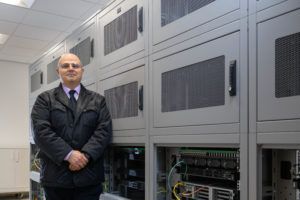by George Yazigi, DARTeC (Digital Aviation Research and Technology Centre), Cranfield University
The future of aviation, its operations and evolution, will be dependent on digital environments: immersed in digital communications, data sharing, analysis and simulations that will make a faster-growing and even more complex airspace, filled with ever-changing technology, a sustainable proposition.
None of this will be possible without high performance computing. At Cranfield University we have HILDA (Hypercomputing Integrated Layer for Digital Aviation) — a supercomputer named after local hero Hilda Hewlett, an aviation pioneer in the late nineteenth and early twentieth century.
Hewlett was the first woman to gain a pilot’s license in the UK and was a partner in setting up the country’s first flying school. She was also involved in the early manufacturing industry, building more than 900 aircraft at a factory in nearby Luton.
HILDA provides a digital aviation ecosystem for researchers and Cranfield’s industry collaborators working with DARTeC, the university’s new Digital Aviation Research and Technology Centre.
DARTeC’s HILDA is a layer of digital support filled with ready-made building blocks of data and software tools for breakthrough research and innovation, working as an integrated part of activities at the Centre. Researchers are able to plug into existing stores of knowledge and simulations without needed to start from scratch on projects.
In general terms, HILDA means accurate and reliable digital models of physical realities, and for the digital and material worlds to work more effectively together. The supercomputer runs hugely detailed simulations in real time, processing complex algorithms and Big Data from sensors and other sources of data needed for machine learning and deep learning around the performance of aircraft and the environments they operate in.
Computational power
The engine to HILDA is made up of NVIDIA A100 Graphic Processing Units and Intel multicore Central Processing Units: 4,576 computing cores, 110,592 CUDA cores, 6,912 TensorFlow cores (to support machine learning — the way in which Artificial Intelligence is used to allow systems to ‘learn’ for themselves). In addition there are 24,576 dedicated CUDA cores for more demanding graphics rendering tasks. There is 15 terabytes of available RAM, backed up by 2.7 petabytes of storage.
Since the 1960s there has been an ongoing race to design ever more powerful supercomputers. Until the 1980s the competition was all around achieving megaflops (millions of flops, as in floating point operations or calculations, every second). By 1989, gigaflops had become possible; then, by 1997, teraflops.
The first ever petaflop speed — a thousand trillion calculations per second — was achieved by IBM’s Roadrunner supercomputer in 2008 (developed at a cost of $133 million). The power of Roadrunner was explained at the time like this: “If all six billion people on Earth used hand calculators and performed calculations 24 hours a day and seven days a week, it would take them 46 years to do what the Roadrunner can do in one day.”
Using a 200GB Infiniband fabric coupled together with the above-mentioned specs, the processing power of HILDA is estimated to be 10.2 petaflops AI (theoretical combined). To put this into perspective, and taking into considerations a few assumptions, this is six trillion times faster than the first computer designed at the University of Cambridge in 1949.
If HILDA was eligible, for example, it would most likely rank in the top ten of the Green500 list of supercomputers (www.top500.org), owing to its architecture, software stack and low power utilisation.
Faster simulation
For Cranfield and its partners, the vast algorithms and simulations which may have taken anything from 40 to 60 days to run, take only a matter of 16 hours. For the aviation sector, this kind of digital ecosystem is critical for the future of aviation research.
HILDA is currently working on an array of research projects that are essential to the future development of global airspace and aviation operations. This includes testing next generation air traffic control systems able to deal with the complexity of an airspace made up of both conventional manned aircraft and different forms of unmanned aerial vehicles or ‘drones’; a facial recognition technology for airport gates that will mean the end of queuing through check-in and passport checks; the testing of elements of aircraft engineering and their impact on performance and fuel consumption, environmental analysis, and tracking optimizations for aircraft maintenance are also running on HILDA’s environment.
There has also been the creation of digital twins of aircraft, virtual replicas that allow for modeling and prediction of performance in different situations and be the basis for improvements.
The UK’s aviation market is one of the largest in the world. It involves industries that are currently under huge pressure to transform themselves in order to meet net zero carbon emissions targets — innovation across every area of aviation is critical.
HILDA will be playing an important part in the coming years of transformation — and for the UK as a whole, will also help towards meeting the Government’s ambition for the nation to be a STEM research superpower, leading on innovations in engineering and technology.
 George Yazigi is digital systems architect and manager, DARTeC (Digital Aviation Research and Technology Centre), Cranfield University, UK
George Yazigi is digital systems architect and manager, DARTeC (Digital Aviation Research and Technology Centre), Cranfield University, UK





